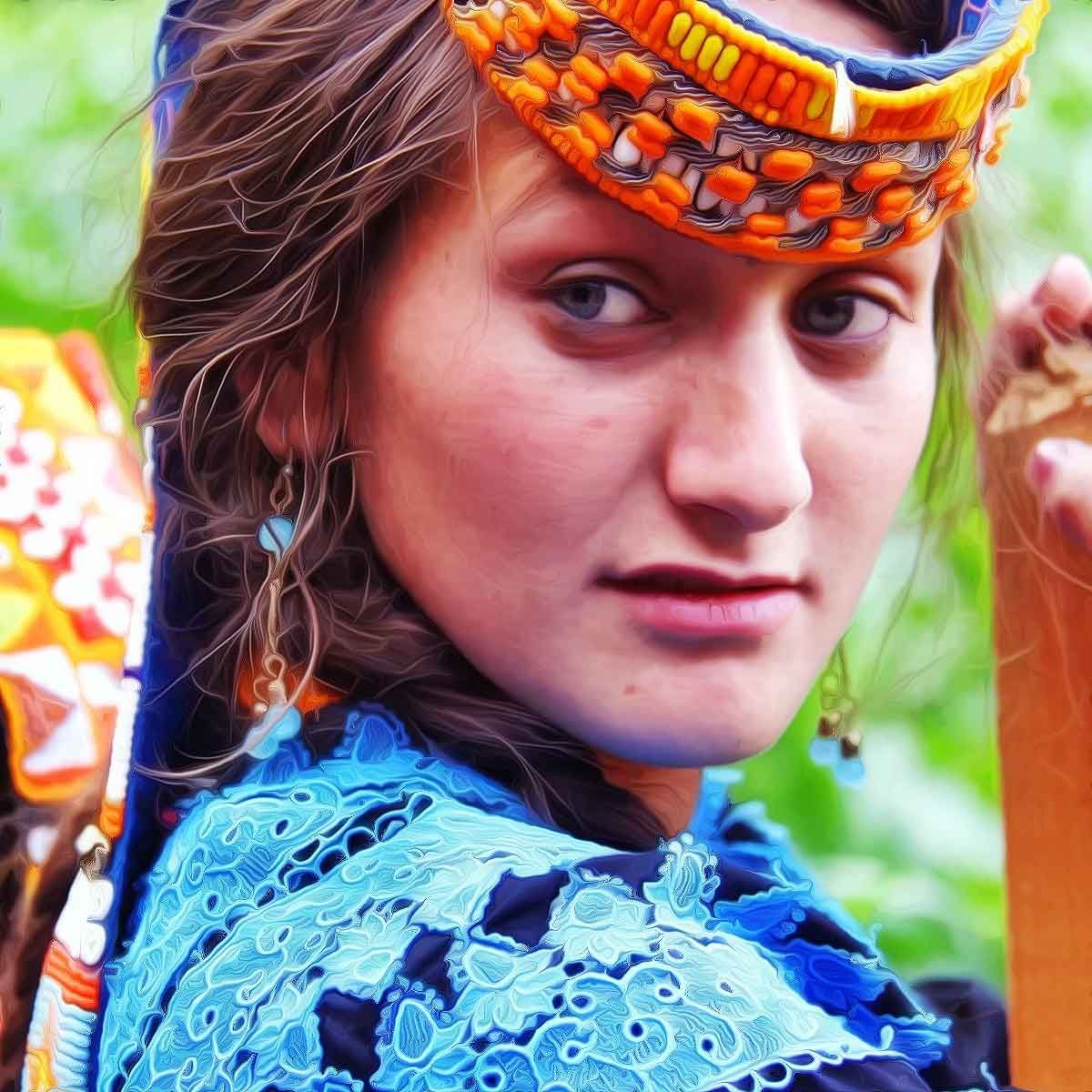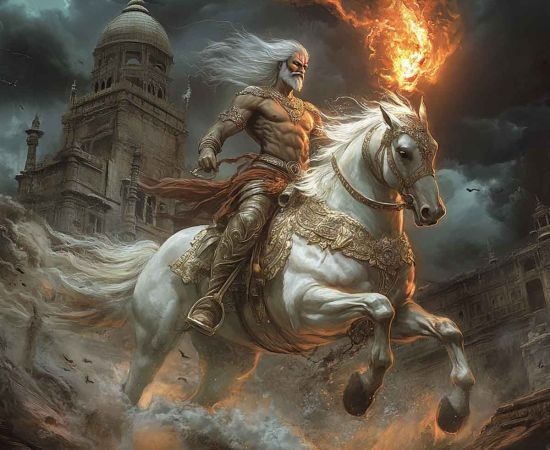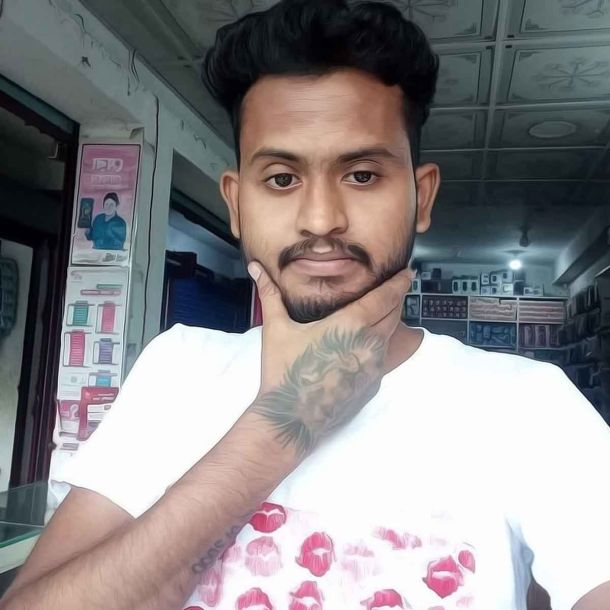MORE COVERAGE
Twitter Coverage
Satyaagrah
Written on
Satyaagrah
Written on
Satyaagrah
Written on
Satyaagrah
Written on
Satyaagrah
Written on
JOIN SATYAAGRAH SOCIAL MEDIA
"Extinction isn't pretty, especially when you know it's coming and do nothing about it": A tribe in Pakistan living in mountains of Hindu-Kush, practice ancient form of Hinduism "Kalash" are facing an existential crisis & being forced to convert to Islam

Do you know there is a tribe in Pakistan that lives in the mountains of Hindu-Kush and practice an ancient form of Hinduism called "Kalash."
|
The Kalash kafirs (kafiristan) are facing an existential crisis and are being forced to convert to Islam. These people living in 3 remote mountainous valleys in Pakistan are the last remnants of the ‘Kafirs’ of the Hindu Kush. In 1896 they are more than 100,000.
Today they are around 3,000, which indicates a drastic decline in the population of those Kalasha people. The smallest ethnic and Dharmic community in Pakistan is fighting for the survival of its culture and religious identity, in the face of religious extremism, forced conversion, migration, and climate change. Are we going to allow this rich culture to vanish from the pluralistic land of Akhand Bharat?
Pakistan’s Ethno-Religious Structure
Before we go into an elaborate analysis of the current situation of the Kalash people, it is important to understand the ethnic and sectarian backdrop of the Islamic Republic of Pakistan. For a long time, Pakistan has been known to abhor the recognition of various ethnic identities. This in many ways resulted in the creation of Bangladesh in 1971 and the various insurgencies that plague the country even to this date. Within its own fabric, because of an unwritten policy of ‘othering’, the country has alienated its minorities be it the Muhajirs, Balochis, Shias, Ahmadis, Ismailis, and so on and so forth. As described above, with a scanty population of 3,000 people, the Kalash are not even 1% of the population; but the uniqueness of their being and their composite history and heritage adds immense value to the vast landmass they belong to, which once upon a time was home to not only Islam but also Buddhism, Hinduism, and other animistic religions. With this background, the Kalash people can be understood as being ethnically marginal while constituting a demographically insignificant minority in a nation created on the grounds of religion.
Over the years, Pakistan’s fundamental problem has been its fractured national unity, polarised as it has been with ethnic and sectarian differences. The central point here is poor governance, economic disparities, and fragmented society & eliciting alliances for personal and not collective gains. The ethnic tension of Pakistan is also entwined with the confusing federal identity of the country. In the Lahore Resolution of March 23, 1940, the Muslim League had maintained that ‘the federating units of Pakistan would be autonomous and sovereign’. That is why throughout the history of independent Pakistan this aspect of the Resolution has nearly always been quoted by advocates of the autonomy of federating units. The Resolution also mentioned that the central government would be limited to defence, foreign affairs, foreign trade, communications, and currency. In a way, history does explain why ethnic tensions are built into the very political fabric of Pakistan. The Pakistani state that emerged from the partition of 1947 tried to put together warring ethnic groups that had never before been united in the same polity prior to the arrival of the British. As is known, it continues to be an effort in progress even today.
On records, Pakistan is a multi-ethnic, linguistic and religious country. Each province is associated with a certain ‘dominant’ ethnic group, and their corresponding language – Punjab with the Punjabis, Sindh with the Sindhis, Balochistan with the Balochis, and Khyber Pakhtunkhwa (KP, renamed from North-West Frontier Province under the 18th amendment of 1973 Constitution) with the Pashtuns. The ‘other’ groups in these provinces are Muhajirs/ Mohajir, Baloch, and Pashtun in Sindh; Saraikis, Sindhis, Brahvi, and Pashtun in Balochistan; Siraikis in Punjab and Hindo and Saraikis in the Tribal areas. According to the CIA World Fact book (as updated on 16th April 2013), the percentage of Punjabis in Pakistan is 44.68, Pashtuns 15.42, Sindhis 14.1, Saraikis 8.38, Muhajirs 7.57, Balochis 3.57 and others 6.28. In terms of religious diversity, according to estimates compiled from the CIA World Factbook and Pakistan Bureau of Statistics Pakistan has 96.28% Muslims of which 85–90% are Sunnis, 10–15% Shias; 0.22% Ahmadi; 1.59% Christian, and 1.60% Hindu population. Interestingly, while the Constitution establishes Islam as the state religion, Articles 20-22 protect the rights of freedom of religion and religious education & Articles 26 and 27 prohibit discrimination based on religion in relation to access to public places and provision of public services. Despite these constitutional safeguards it is widely known that any open support to forms of exclusiveness whether linguistic, ethnic, or religious, causes much blood-shed within Pakistan.
Sometime in April 2017, a provincial court in Peshawar officially recognized the Kalash community as a separate ethnic and religious group. Recognition was the culmination of a long fight in the predominantly Islamic country, where religious and other minorities often come under scrutiny by authorities and even attack by militants. However, the common perception within Pakistan, is that the state is not ethnically neutral and the dominant linguistic group is of the Punjabis. The key institution where this preponderance is most apparent is the army, particularly at the highest level. The reason for Punjabis’ relative contentment within the country has been their overwhelming representation in the state apparatus both in terms of the military and the civil bureaucracy as well as in sectors like business, commerce, and industry. Moreover, after the secession of East Pakistan in 1971, they became a predominant majority in terms of provincial share further consolidating their hold over governance within the country.
|
Who are the Kalash
Speaking in strictly scientific terms, human populations show subtle allele-frequency differences across geographical spaces and according to available methods individuals tend to be clustered based on their genetic information into groups that correspond to their respective geographical regions. In an early global survey of this kind, five clusters were identified (1) Africans, (2) a widespread group including Europeans, Middle Easterners, and South Asians, (3) East Asians, (4) Oceanians, and (5) Native Americans. However, when the divisions were increased to include a sixth group: it comprised only of a single population, that of the Kalash.
As has been mentioned earlier, the Kalash are an isolated South Asian population of Indo-European speakers residing in the Hindu Kush mountain valleys in the northwestern part of Pakistan, near the Afghanistan border. They represent a religious minority with unique and rich cultural traditions. As their number is constantly shrinking, the Kalash people are found to be staying in three valleys of the Hindu Kush: Rumbur, Bumburet and Birir in the Chitral district of Khyber Pakhtunkhwa. The Rumbur and Bumburet grouping form a single culture due to similarities in their cultural practices, while the Birir grouping being the most traditional one of the three, forms a separate culture of its own. The region is at the crossroads of what is known as the Nuristan province of Afghanistan in the west, Swat and Gilgit in the east, Pamir Knot in the north and Lowari Pass in the south. The Kalash language is said to be part of the Dardic group of Indo-Aryan languages. As per UNESCO, the language is listed as being critically endangered as like many other tribal languages all over the world, Kalash has no proper script. On its part, even the Government of Pakistan has made no effort to document and keep a record of this unique language. What is even worse is that till date there does not exist a single standard text devoted solely to this culture.
The term ‘Kalash’ is used to refer to many distinct people including the Väi, the Čima-nišei, the Vântä, plus the Ashkun- and Tregami-speakers. The Kalash are considered to be an indigenous people of Asia, with their ancestors migrating to Chitral valley from another location possibly further south, which the Kalash call “Tsiyam” in their folk songs and epics. Some of the Kalash traditions consider the various Kalash people to have been migrants or refugees. They are also considered by some to have been descendants of Gandhari people. The Kalasha language, also known as Kalasha-mun & Its closest relative is the neighboring Khowar language.
Kalasha women usually wear long black robes, often embroidered with cowrie shells. For this reason, they are known by Muslims in Chitral as “the Black Kafirs”.Men have adopted the Pakistani shalwar kameez, while children wear small versions of adult clothing after the age of four.
The three main festivals of the Kalash are the Chilam Joshi in the middle of May, the Uchau in autumn, and the Caumus in midwinter. The pastoral god Sorizan protects the herds in Fall and Winter and is thanked at the winter festival, while Goshidai does so until the Pul festival and is thanked at the Joshi festival in spring. Joshi is celebrated at the end of May each year.
|
Kalash deities are:
- Indr: As in the Veda, the rainbow is called after him. When it thunders, Indra is playing Polo. Indra appears, however, in various forms and modern 'disguises', such as Sajigor (Sajigōr), also called Shura Verin
- Munjem Malék: Another god, Munjem Malék, is the Lord of Middle Earth and killed, like Indra, his father. Mahandeo, is the god of crops, and also the god of war, and a negotiator with the highest deity.
- Mahandeo: Mahandeo is a deity whom the Kalash pray to and is known as Mahadev in other languages of the Indian subcontinent in modern Hinduism
- Imra: Certain deities were revered only in one community or tribe, but one was universally revered as the Creator: The ancient Hindu god Yama Râja called imr'o in Kâmviri. There is a creator god, appearing under various names, no longer as Father Heaven, but as lord of the nether world and of heaven: Imra (*Yama Rājan), Māra 'death' (Nuristani) He (Yama rajan) is a creator deity called Dezau (ḍezáw) whose name is derived from Indo-European *dheig'h 'to form',
- Jestak: Jestak is the goddess of domestic life, family, and marriage
- Krumai & Suchi, Varōti, and Jach: There also is a general pattern of belief in mountain fairies Suchi, who help in hunting and killing enemies, and the Varōti (called vātaputrī in Sanskrit), their violent male partners of Suchi, reflecting the later Vedic (and typical medieval Kashmiri) distinction between Apsaras and Gandhar
- etc. who resemble a large extent the deities of Indic folklore.
The Kalash people are animists, and nature worshippers and refuse to convert to Islam. It is this emphasis on non-conversion that can be perceived as the root cause of their marginalization in the region.
A leader of the Kalash, Saifulla Jan, has stated, "If any Kalash converts to Islam, they cannot live among us anymore. We keep our identity strong."
About three thousand have converted to Islam or are descendants of converts, yet still, live nearby in the Kalash villages and maintain their language and many aspects of their ancient culture. By now, sheikhs, or converts to Islam, make up more than half of the total Kalasha-speaking population.
Living within an Islamic State, pressure to convert to Islam has always been there on the Kalash & has existed for nearly centuries. In fact, at one point in time, the Kalash people had similarities in traditions and cultural practices with the local people of neighbouring Nuristan province of Afghanistan. Interestingly this area was known as Kafiristan- land of the Kafir. The Kalash who live today in the valleys of Hindu Kush are the last survivors amongst the people of Kafiristan, an area that once encompassed entire northwest Pakistan and eastern Afghanistan before the region was divided by the Durand Line, the border established between Afghanistan and British India in the 19thcentury. It is believed that in 1895 Amir (King) Abdur Rahman Khan, the king of Afghanistan, conquered the area and forced the inhabitants to convert to Islam. Known as the “Iron Amir,” he proceeded to name the area Nuristan, or the “Land of Celestial Light”. Around this time, the Kalash were brutally conquered; their ancient temples and wooden idols were destroyed; their women were forced to burn their folk costumes and wear the burqa or veil, and scores of people were converted at sword point to Islam. Fifty years later, two Kalash valleys of Jinjeret kuh and Urtsun were forced to adopt Islam. However, three remaining valleys could be saved from this tyranny apparently because the Prince of Chitral preferred to use them as slaves in the way they existed. Nevertheless as per records, over the past few decades, almost 50% of the total population in Kalash has converted to Islam.
|
Forced conversion of Kalash People of Nuristan
The Kalash people live primarily in the Kalash Valley, Chitral District, Khyber Pakhtunkhwa Province of Pakistan. Chitral District is connected to Nuristan, a province of Afghanistan. Nuristan is also known as Kafiristan (“Land of Kaafirs” as given by Muslims), and the culture in this Afghanistani Province was similar to that of the Kalash.
The first historically recorded Islamic invasions of their lands were by the Ghaznavids in the 11th century, while they themselves are first attested in 1339 during Timur’s invasions. Nuristan had been forcibly converted to Islam in 1895–96.
People of Kafiristan were converted to Islam in 1890s and then Kafiristan became Nuristan.
|
Significant issues for the Kalash people
Preservation of their identity – Pakistan inherited a very diverse populace, both ethnically and religiously. However, the religious fundamentalist groups have insisted on calling it an Islamic nation of a particular kind ignoring the thousands of years of history of communities and nations that the region once belonged to. The Kalash is one of the few living indigenous cultures still surviving in the world. But they are struggling to save their rich and ancient heritage caught between the Taliban on one side along the border with Afghanistan, and other fundamentalists socio-economic and religious forces on the other side thriving in Pakistan. With the non-Kalash population overwhelming them at every level, they face serious threats of extinction. The immediate threats include their unwillingness to convert to Islam and cajoled marriages of Kalash women with non-Kalashmen.
Preservation of the forest as part of their dwelling – Rampant cutting of wooden logs is another aspect impacting the lifestyle of the Kalash people in a serious manner. As a tribe, they are known to depend heavily on forests for their livelihood as well as for their rituals & cultural practices. Interestingly, they are considered legal collective owners of forest lands in the three valleys they live as per the local customs. However, in recent times, non-Kalash residents have started claiming ownership rights which they are too small in number to effectively refute. According to NCHR Report, dated 2017, the most urgent complaint of the Kalash elders is that they are being deprived of their centuries-old claims of ownership over the Silver Oak forests in the Kalash Valleys. The forests, the report points out, are important economically as well to the tribe, not to forget their religious significance. Loss of ownership of these directly translates into a loss of livelihood. But, in complete disregard to the ancient practices, the land revenue officials seem to have told them that the Silver Oak forests are part of “Shamilaat”, which means that a Kalash family cannot exercise its privileged right over the forest rather it would have to share the forest with all the concerned land owners (Muslims and non-Kalash residents) of the area.
Government schools in the valley – With the overt pretext of imparting education to children and mainstreaming them, the schools in the area it is alleged to have been trying to alienate the young pupils from the Kalash way of life. By emphasizing only the teachings of Allah in Arabic, a sense of inferiority is being deliberately imbibed amongst these students regarding their own religion. The marginal improvement caused due to education in these three valleys a way is at the cost of danger to their indigenous non-Islamic culture. The elderly people in the community have expressed worry that the advent of the modern lifestyle and the younger generation’s proximity to the Islamic way of life and teachings (when they go to school) are likely to usher in many irreversible changes which could potentially wipe out their uniqueness so carefully preserved. Activists also complain the rate of conversions is growing by the year because, in the absence of a curriculum for the minority community in government schools, Kalash students are forced to opt for Islamic studies.
The problem of connectivity – The absence of a proper road to link the valleys to the rest of the country has over the years discouraged local and foreign tourists to show up in large numbers at their annual festivals. It also makes it enormously difficult for the community to transport patients to hospitals in Chitral for treatment during medical emergency. Though in 2017, the Lowari Tunnel, connecting Chitral, where the Kalash live, to the district of Upper Dir was formally inaugurated,the Kalash themselves, however, hardly get any benefit from related businesses as these enterprises are largely controlled by non-Kalash people. The dilapidated condition of the roads leading to the three valleys are in a stark contrast to the scale and quality of the project implemented at Lowari Tunnel, clearly reflecting how Pakistan treats its minorities. The hazardous road conditions are a major impediment to the socio-economic welfare of the entire population that is battling numerous difficulties to survive in the region.
Danger the community is experiencing
Ironically, the Pakistani establishment often uses these colorfully dressed tribal people to demonstrate the country’s diversity. This is in sharp contrast to their not so colourful reality of oppression and discrimination in the hands of the majority community. Today the Kalash people face massive pressure from surrounding Islamic communities who are constantly pushing towards Islamization of the three valleys inhabiting this tribe. That, coupled with the fact that the valleys are in a region where the Pakistani government has de-facto no control, makes the future of the ancient culture of the Kalash unknown. As the Kalash do not believe in divine books and messengers, ‘their disbelief’ makes them kafir or infidels in the eyes of the dominant Muslim community.
As early as 1992, a study conducted by Institute for Current World Affairs, specified the risks involved in the existence of a separate animist Kalash identity in the valleys inhabited by them. It states how local non-Kalash people, both Muslims and Christian missionaries frequently put financial pressure and provided incentives to these people for religious conversion. Local Muslims are even known to have attempted to force Kalash people to convert to Islam & give up their lands in exchange for debt forgiveness. Christian missionaries have also lured the individual Kalash families with electricity and stipend for the children. Interestingly, the report further states that as conversion through missionaries is illegal in Pakistan, these Christians visit the valleys posing as artists, refusing to divulge their actual source of income.
The poor economic conditions of these people are also used as a tool for conversion in exchange for jobs. Activists and researchers also note that the Kalash settlements are being rapidly encircled by a growing Muslim population as over the years the community has lost control over large parts of their lands through sale or mortgage. Thus socio-economic deprivation is an important factor accountable for the community’s decline. This problem has its sociological effects driving Kalash women to marry outside the community. Increasingly, it seems Kalash women marry non-Kalash men with the stated intention of having a better life, and eventually, the women convert to Islam, giving up their original way of life.
In recent times, the Afghan conflict and the frantic efforts at Islamization have posed dangers to the survival of the Kalash. In the 1980s, the people got the first taste of things to come when some Tablighi zealots illegally occupied a large cultivated piece of their land in Bumburet and built a mosque. What happened after that is not hard to discover. The Afghan refugees and the Pathan Tablighi parties seized nearly 70% of their land during the period, 1981 to 1995. The first effect of the Afghanistan jihad for the Kalash was the decimation of their forests and wildlife by the refugees. As the vegetation grew sparse, their cattle met the same fate as their forests, and the traditional Kalash means of livelihood were irreparably destroyed. Unfortunately, once the Afghan refugees and the Tablighis became entrenched in Chitral, forced conversions also began. Gun-toting Tablighis made it clear that in order to live in Pakistan, the Kalash must convert to Islam.
Post 9/11 the situation has been very tense for the Kalash resulting in an existential crisis. Following US operations in the neighboring Nuristan province of Afghanistan, scores of Taliban militants were rushed out into the district of Chitral, causing an enormous threat to the locals. In 2009, a Taliban unit entered the valleys at night and kidnapped a Greek teacher, Lerounis. He was taken swiftly across the Afghan border to Nuristan, and his ransom, thought to be up to £1 million, was paid and he returned to Greece. The Taliban also released a 50-minute video on February 2, 2014, announcing an ‘armed struggle' against the Kalash and Ismaili Muslims in the Chitral Valley and calling on Sunnis to support their cause. In another such incident, in July 2016, the Taliban attacked Kalash shepherds in Bumburet Valley. Most of the Kalash ran, and the Taliban slaughtered two shepherds and herded almost their 300 sheep across the border to Nuristan.
It is apparent that the pressure from the dominant religion is no doubt causing a change in the behavioral pattern of these people, especially their future, and their children. Kalash children are not taught about their own culture, religion, or history in schools, where most of the teachers are Muslims. As reported in April 2019, calls to pray now ring five times a day from 18 mosques across the Bumburet valley, the result of a boom in the construction of Muslim houses of worship. The swelling influence of Islam in the area has alarmed many in the Kalash community who worry that their traditional way of life is slipping away right before their eyes.
Conclusion
The Kalash people are the last of the surviving indigenous communities of the Hindu Kush. They are the remnants of what was once a unique region with a varied culture marked by beautiful valleys, orchards, mountains, and rivers. The aggressive Islamization and the apathy of the State are two aspects rapidly engulfing the local people within the fold of a regimented religion. The meager population of the Kalash and the surrounding hostile habitat have created tremendous pressure as they increasingly become less celebratory of their own religious festivities and rituals. Battling an existential crisis, it is ironic that those with no understanding of peaceful co-existence put the Kalash to scrutiny over their very ethos and way of life.
References:
Michael Witzel, The Ṛgvedic Religious System and its Central Asian and Hindukush Antecedents.
Cacopardo, Augusto S. (2016) Pagan Christmas. Winter Feasts of the Kalasha of the Hindu Kush.
Indic Studies Toronto
”Tribe of Kalash: The Last Kafir”. Global Human Rights Defence. 1 March 2021
 Support Us
Support Us
Satyagraha was born from the heart of our land, with an undying aim to unveil the true essence of Bharat. It seeks to illuminate the hidden tales of our valiant freedom fighters and the rich chronicles that haven't yet sung their complete melody in the mainstream.
While platforms like NDTV and 'The Wire' effortlessly garner funds under the banner of safeguarding democracy, we at Satyagraha walk a different path. Our strength and resonance come from you. In this journey to weave a stronger Bharat, every little contribution amplifies our voice. Let's come together, contribute as you can, and champion the true spirit of our nation.
 |  |  |
| ICICI Bank of Satyaagrah | Razorpay Bank of Satyaagrah | PayPal Bank of Satyaagrah - For International Payments |
If all above doesn't work, then try the LINK below:
Please share the article on other platforms
DISCLAIMER: The author is solely responsible for the views expressed in this article. The author carries the responsibility for citing and/or licensing of images utilized within the text. The website also frequently uses non-commercial images for representational purposes only in line with the article. We are not responsible for the authenticity of such images. If some images have a copyright issue, we request the person/entity to contact us at satyaagrahindia@gmail.com and we will take the necessary actions to resolve the issue.
Related Articles
- "Traitors wear many masks but have only one face": J&K Bank's Chief manager, Sajad Ahmad Bazaz, sacked for shadowy ISI links, manipulating media with bank funds, and ties to extremist leaders, was planted for advancing the extremist-separatist ideology
- Shoaib Akhtar endorses AMU founder’s two-nation theory that caused partition: Not some stupid comment but a statement of fact
- In a major breakthrough, Police have recovered IEDs smuggled across the border to Pakistan backed terrorist sleeper cells, linked to Dawood Ibrahim’s terror module: a number of explosives have also made their way into Gujarat via the water route
- "Voices of cold reason were talking, as usual, to deaf ears": Plight of abducted Hindu Girls in Pakistan goes unheard as once again a minor Hindu girl Sohana Sharma abducted, converted, and married off to a Muslim, court refuses her return to the family
- "Cow for slaughter raised from rooftop ahead of Eid-al-Adha": Barbarians call it an "enjoyable" annual ritual that they come to watch with family, Reuters covers it as some exotic custom, utterly overlooking how it's deeply interconnected with kaafir hate
- Imran Khan offends Afghans by offering to send 'professionals' to help Afghanistan: Afghan citizens, officials, and even Taliban rulers have declined the offer saying that the Islamic Emirate of Afghanistan does not need cooperation in this regard
- Speech of Sardar Patel at Calcutta Maidan in 1948 busts the myth of ‘Muslims chose India’ and is relevant even today
- Karachi's 150-year-old Shree Mari Mata Mandir faces demolition, amid allegations and land disputes, Pakistan's Tamil community mourns the loss of their sacred space, while yearning for justice and respect in a land they've called home for generations
- Direct Action Day triggers The Great Calcutta Killings: Kolkata Paid Its Lives To Create Pakistan
- Pakistan PM Imran Khan's close friend ‘Lord’ Nazir Ahmed convicted of sexually harassing children: Anti-India agent of Pakistan
- Campus Front of India group carries out rally promoting violence against UP CM Yogi Adityanath
- Dewan Bahadur saheb was made to quit as a Speaker because he wasn't a Muslim: Tragedy of a Christian leader who backed Pakistan’s creation
- Operation Polo: When India annexed Hyderabad from the Nizam and Razakars, the suppression of Hindus and the role of Nehru
- Violence Against Minority Hindus in Bangladesh: The Mistier World Of Silence
- Five LeT terrorists planned bomb blast at Darbhanga railway station, had visited Pakistan several times: NIA files charge-sheets



























